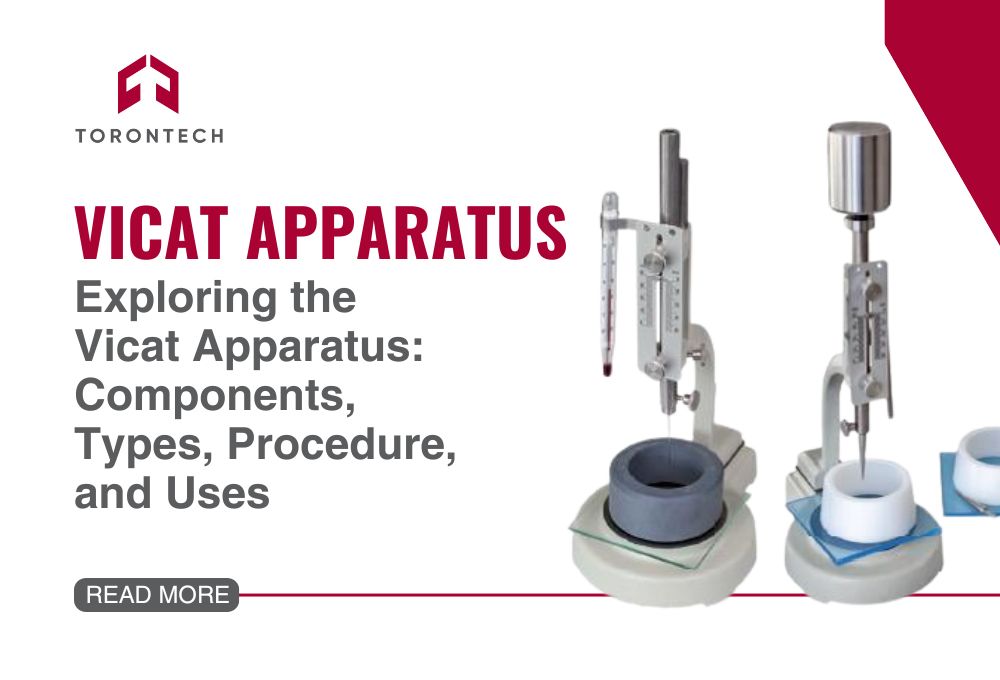Vicat apparatus is an important instrument in civil engineering and construction for measuring the setting time and consistency of cement. This device ensures that cementitious materials meet necessary performance standards, impacting everything from the timing of concrete placement to the durability of finished structures.
But, why is understanding the Vicat apparatus crucial for professionals in quality control and material testing? In this blog post, we will explore the Vicat apparatus’s components, types, and testing procedures, as well as its practical applications in construction projects.
Understanding these aspects is crucial for professionals in quality control and material testing, highlighting the apparatus’s significant role in ensuring cement quality and reliability in the modern construction field.
Components of the Vicat Apparatus
Have you ever wondered how construction professionals ensure the perfect consistency and setting time of cement? The answer lies in the precise functionality of the Vicat apparatus. This instrument consists of several critical components, each playing a crucial role in the testing process.
- Vertical Rod: The central support structure of the Vicat apparatus, ensuring alignment and stability during testing.
- Vicat Needle Apparatus: Used to measure the penetration resistance of the cement paste, essential for determining initial and final setting times.
- Vicat Plungers: Utilized to determine the standard consistency of the cement paste, featuring different attachments to measure various parameters.
- Vicat Mould: Holds the cement paste uniformly during the test, providing a controlled environment for measuring setting characteristics.
- Movable Platform: Supports the Vicat mould and facilitates accurate penetration measurements by moving smoothly and consistently.
Understanding the function of each part helps in comprehending the overall operation and importance of the Vicat apparatus in quality control and material testing.
Types of Vicat Apparatus
Selecting the right Vicat apparatus is crucial for achieving accurate and reliable cement testing results. The instrument comes in two types and is used to cater to various needs and ensure accurate results. Understanding these variations is crucial for you selecting the right type for your specific applications.
1. Standard Vicat Apparatus
This is the go-to model for many in the construction industry, manually operated and widely used for routine quality control tests. The standard Vicat apparatus includes essential components like the vertical rod, Vicat needle, movable platform, and Vicat mould. All designed to deliver precise measurements of cement’s setting characteristics.
2. Automatic Vicat Apparatus
For those seeking efficiency and consistency, the automatic Vicat apparatus is a game-changer. It automates the testing process, reducing the need for manual intervention and minimizing human error. This advanced model is ideal for high-volume testing environments where reliable and repeatable results are critical.
Choosing the right type of Vicat apparatus can significantly impact the accuracy and reliability of cement testing. So be careful and identify your application to make sure your construction materials meet stringent quality standards.
How to Conduct a Vicat Apparatus Test?
Ensuring the proper setting time and consistency of cement is essential for the quality of construction projects. The Vicat apparatus test is a standardized procedure that provides accurate measurements of these critical parameters. So, how do you use this instrument correctly to achieve reliable results?
1. Preparation of Cement Paste
The test starts with mixing cement and water to create a uniform paste. The water amount is typically determined by the standard consistency test, ensuring the paste has the correct consistency for accurate measurements.
2. Setting Up the Apparatus
The prepared cement paste is placed into the Vicat mould, which is then positioned on the movable platform. This setup ensures the paste is uniformly compacted and ready for testing.
3. Testing for Consistency
To determine the standard consistency, the Vicat plunger is gently lowered into the paste. The depth of penetration indicates whether the paste meets the required consistency standards, crucial for its workability.
4. Measuring Initial Setting Time
The initial setting time is measured by lowering the Vicat needle onto the surface of the paste at regular intervals. The initial setting time is recorded when the needle can no longer penetrate the paste to a specified depth, indicating the start of the setting process.
5. Measuring Final Setting Time
The final setting time is determined by continuing to lower the needle until it no longer leaves an impression on the surface of the cement paste. This indicates that the cement has fully set and is ready for structural use.
Vicats apparatus is used to determine the setting characteristics of cement, helping construction professionals ensure their materials meet performance standards. Performing the test accurately is importantl for understanding the workability and setting characteristics of cement.
Applications of the Vicat Test Apparatus
The Vicat test apparatus is integral to various sectors within construction and civil engineering. It ensures the consistency and setting characteristics of cement, providing essential data for numerous applications. But what are the specific applications where this apparatus proves indispensable?
1. Quality Control in Cement Production
Vicat’s apparatus is used to determine the consistency and setting times of cement, ensuring each batch meets stringent quality standards before use in construction. This uniformity helps maintain reliability in the final product.
2. Research and Development
In research and development laboratories, the Vicat apparatus is employed to test new cement and concrete formulations. By analyzing the impact of different mixtures and additives on setting times, researchers can develop improved materials tailored for specific applications.
3. Construction Site Monitoring
On construction sites, Vicat’s apparatus is used to perform on-site testing of cement to ensure materials meet project specifications. This prevents issues related to premature setting or inadequate curing, ensuring the quality of the construction.
4. Optimization of Construction Processes
By understanding the setting times of different cement batches, construction managers can optimize processes such as mixing, transporting, and pouring. This optimization leads to more efficient project management and reduced downtime.
5. Educational Purposes
Vicat’s apparatus is used to perform educational demonstrations, helping students learn about the properties of cement and concrete. This hands-on experience provides future engineers and construction professionals with practical knowledge of material properties and testing methods.
These applications highlight the importance of the Vicat test apparatus in ensuring the quality and performance of cementitious materials. This instrument will helps maintain the integrity of construction projects and supports the development of innovative materials.
Let’s Explore More About Vicat Apparatus
The Vicat apparatus is important for ensuring the quality and consistency of cement in construction projects. It is beneficial in quality control, research, and compliance with standards. This instrument is used to perform critical tests, providing accurate measurements that help maintain the integrity and durability of construction materials.
Understanding the components, types, and applications of the Vicat apparatus is key for professionals in the construction and civil industry. To learn more about our products or if you need assistance, please visit our website or contact us. We are here to support your construction and material testing needs with top-quality equipment and service.
Frequently Asked Question (FAQ)
Q: What is a Vicat Apparatus used for?
A: The Vicat Apparatus is used to determine the setting time and consistency of cement. It measures how long it takes for cement to start and finish hardening, which is crucial for ensuring the quality and workability of cement in construction projects.
Q: What are the compliance standards for the Vicat Apparatus?
A: The Vicat apparatus must comply with several international standards to ensure accuracy and reliability. Key standards include ASTM C191 (Standard Test Methods for Time of Setting of Hydraulic Cement by Vicat Needle), EN 196-3 (Methods of Testing Cement – Part 3: Determination of Setting Times and Soundness), and ISO 9597 (Methods of Testing Cements – Determination of Setting Time and Soundness).
Q: What is the purpose of the Vicat test?
A: The purpose of the Vicat test is to measure the initial and final setting times of cement. This test helps in assessing the workability and performance of cement mixtures, ensuring they meet specific standards and requirements for construction.
Q: How to use Vicat Apparatus?
A: To use the Vicat Apparatus, you need to prepare a cement paste, place it into the Vicat mould, and position it on the movable platform. The Vicat needle is then lowered onto the paste at regular intervals to measure the penetration resistance, determining the initial and final setting times.
Q: What size needle is used in the Vicat Apparatus?
A: The Vicat Apparatus typically uses a needle with a 1 mm² cross-sectional area for measuring the initial and final setting times of cement. The needle size ensures precise penetration measurements needed for accurate test results





